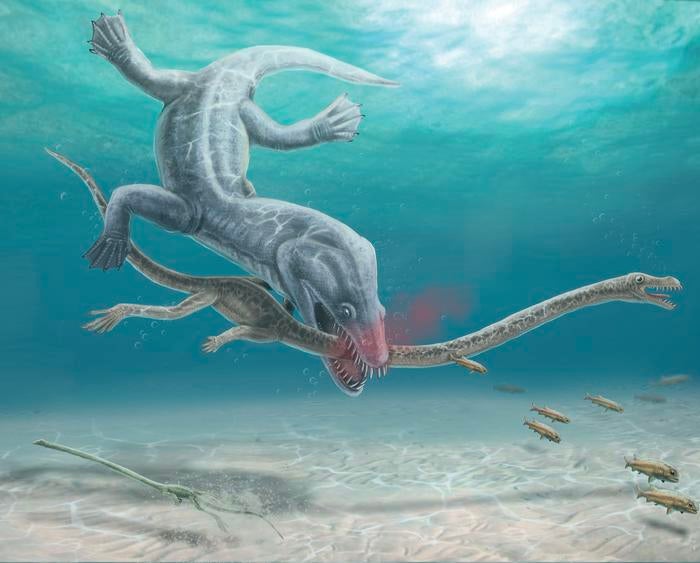Long-necked dinosaur-era sea monsters were vulnerable to decapitation by predators, fossil confirms
Findings show that evolving a long neck as a sea reptile came with potential downsides
Prehistoric long-necked sea creatures were vulnerable to decapitation by their predators, shows the first-ever direct fossil evidence recently unearthed by scientists.
Paleontologists have long suspected that the long-necked bodies of some dinosaurs and their ancient marine counterparts during the time of the dinosaurs made them vulnerable to predators.
And now there is fossil evidence to prove what had earlier just been a theory.
A careful analysis of the fossils of a 240-million-year-old sea monster has revealed that the giant creatures were decapitated with a single, brutal bite by predators.
Bite marks on the unusual necks of two Triassic species of Tanystropheus – a prehistoric reptile distantly related to crocodiles, birds and dinosaurs – was assessed by researchers, including those from the State Museum of Natural History in Germany’s Stuttgart.
The marine reptiles, with their unique necks made of 13 extremely elongated vertebrae, strut-like ribs and stiffened necks, waited to ambush their prey.
But the new study has shown that predators of the marine giant also took advantage of long necks for their own gain.
The necks of the two specimens were found to have clear bite marks on them – in one case right where the neck was broken.
This offers a gruesome and rare insight into predator-prey interactions in the fossil record dating back over 240 million years ago.
“Paleontologists speculated that these long necks formed an obvious weak spot for predation, as was already vividly depicted almost 200 years ago in a famous painting by Henry de la Beche from 1830,” said study co-author Stephan Spiekman.
“Nevertheless, there was no evidence of decapitation – or any other sort of attack targeting the neck – known from the abundant fossil record of long-necked marine reptiles until our present study on these two specimens of Tanystropheus,” Dr Spiekman said.
Before the new discovery, scientists had known two species of Tanystropheus lived in the same environment. One small species, about a metre and a half in length, likely fed on soft-shelled animals like shrimp and a much larger species of up to six metres long fed on fish and squid.
Researchers also found clear evidence earlier, in the shape of a skull, that Tanystropheus likely spent most of its time in the water.

Two fossil specimens of these species also had necks that ended “abruptly” – leading to speculation that they were bitten off.
“Something that caught our attention is that the skull and portion of the neck preserved are undisturbed, only showing some disarticulation due to the typical decay of a carcass in a quiet environment,” said Eudald Mujal, another author of the study.
“Only the neck and head are preserved; there is no evidence whatsoever of the rest of the animals. The necks end abruptly, indicating they were completely severed by another animal during a particularly violent event, as the presence of tooth traces evinces,” Dr Mujal said.
Scientists suspect that the head and neck of these species “were clearly not fed on by the predator”.
They speculate that the predators were less interested in the skinny neck and small head, and instead focused on the much meatier parts of the body.
“Taken together, these factors make it most likely that both individuals were decapitated during the hunt and not scavenged, although scavenging can never be fully excluded in fossils that are this old,” Dr Mujal concluded.
The findings showed that evolving a long neck as a sea reptile came with potential downsides.
“In a very broad sense, our research once again shows that evolution is a game of trade-offs,” Dr Spiekman said.
Join our commenting forum
Join thought-provoking conversations, follow other Independent readers and see their replies
Comments


Bookmark popover
Removed from bookmarks